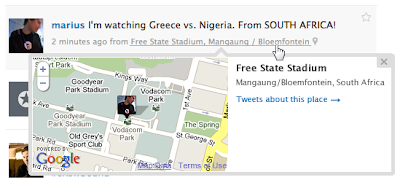Thoughts on Twitter 'Places'

Many of you have heard by now that Twitter this week integrated the ability to annotate tweets with specific place information. This is an extension of the location awareness first integrated in its API and then more recently to Twitter.com.
But instead of tweeting from “San Francisco,” I now get the ability to specify that I’m tweeting from my office. Clicking on a place will also bring up all the recent tweets from that place, and it’s working with Tom Tom and Localeze for the listings data.
This brings Twitter’s model closer to Foursquare in that a tweet from a place can be an implicit “check-in.” Of course it’s meant to be a lot more than that, as 140 characters represent more of a status update than a binary check-in.
Foursquare meanwhile has taken the opposite path by letting users add 140 characters to a check-in. So they’re becoming more and more like each other, which many have argued is tantamount to the death of Foursquare.
That could have some truth, given Twitter’s 190 million monthly users, but the new functionality also seeds Foursquare by letting users view recent check-ins for any venue associated with the service.
Nuts and bolts aside, this could be big news for Twitter and for the local space. If place annotation becomes common practice among Twitter’s massive user base, it will be a major force in pushing forward the social/location space that has been lifting off the ground over the past year.
It could also be the “mainstreaming” of the space that will push advertiser interest, acceptance and adoption to a tipping point. APIs will be available to create modules that filter all the tweets that happen from a given location — a natural fit for any business’ Web site. Still, the realities of SMB self provisioning are a gating factor.
But generally, this takes Twitter to the next level, beyond businesses using it to market business info and promotions to followers. It could also be an on-ramp for many businesses to its recently announced Promoted Tweets program.
A few more implications about what this could mean were dissected in a previous post … excerpt and link below.
Other interesting points about geolocation have more to do with what Twitter, or third parties, decide to do with it. Here’s where some of Andrew Shotland’s prescient points from yesterday come into play.
If you know a user is tweeting from a particular lat/long, why not overlay business listings data to be able to determine that they’re tweeting from “Joe’s Bowling Alley”? Once you know that, the floodgates open for related content (Yelp reviews) or ads (”Pete’s Bowling Alley”).
Back to the user perspective, geolocation also adds an additional dimension of relevance to Twitter search. In other words, filtering tweets not only by keyword but by location. This makes the most sense in mobile, if you are wandering through a new neighborhood and want to find out about all the deals happening around you.
Those deals/tweets would be coming from the businesses, mentioned above, that are tweeting from their locations. This assumes for the sake of argument, that businesses will do this with great enough coverage and frequency to make it a worthwhile user experience. That could take a while to materialize but you get the idea.
So it could work in both directions: Advertisers targeting nearby users, and users searching for nearby businesses. There are lots of ways this could develop, but for now it’s certain that Twitter just got a whole lot more interesting.
Read the rest here.


